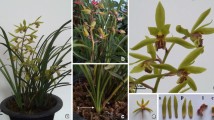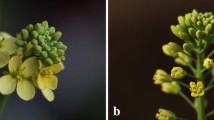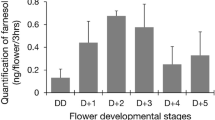Abstract
Cymbidium geringii has high ornamental and economic importance. Its traits, including flower shape, size, and color, are highly sought by orchid breeders. Gaining insights into the molecular basis of C. geringi flower development would accelerate genetic improvement of other orchids. Methods and Results: Here, C. goeringii RNA was purified from normal and peloric mutant flowers, and cDNA libraries constructed for Illumina sequencing. We generated 329,156,782 clean reads, integrated them, and then assembled into 236,811 unigenes averaging 595 bp long. A total of 11,992 differentially expressed genes s, of which 6119 were upregulated and 5873 downregulated, were uncovered in peloric mutant flower buds relative to normal flower buds. Kyoto Encyclopedia of Genes and Genomes enrichment assessments posited that these differentially expressed genes are associated with “Photosynthesis”, “Linoleic acid metabolism”, as well as “Plant hormone signal transduction” cascades. The DEGs were designated to 12 remarkably enriched GO terms, and 16 cell wall associated GO terms. The expression level of 16 determined genes were verified using RT-qPCR. Conclusions: Our gene expression data may be used to study the regulatory mechanism of flower organ development in C. geringi.





Similar content being viewed by others
References
Tsai WC, Chen HH (2006) The orchid MADS-box genes controlling floral morphogenesis. ScientificWorldJournal 6:1933–1944. https://doi.org/10.1100/tsw.2006.321
Xiang L, Chen Y, Chen L, Fu X, Zhao K, Zhang J, Sun C (2018) B and E MADS-box genes determine the perianth formation in Cymbidium goeringii Rchb.f. Physiol Plant 162(3):353–369. https://doi.org/10.1111/ppl.12647
Su SH, Shao XY, Zhu CF, Xu JY, Tang YH, Luo D, Huang X (2018) An AGAMOUS-like factor is associated with the origin of two domesticated varieties in Cymbidium sinense (Orchidaceae). Hortic Res. https://doi.org/10.1038/s41438-018-0052-z
Sun Y, Wang G, Li Y, Jiang L, Yang Y, Guan S (2016) De novo transcriptome sequencing and comparative analysis to discover genes related to floral development in Cymbidium faberi Rolfe. Springerplus 5(1):1458. https://doi.org/10.1186/s40064-016-3089-1
Chen Y, Shen Q, Lin R, Zhao Z, Shen C, Sun C (2017) De novo transcriptome analysis in Dendrobium and identification of critical genes associated with flowering. Plant Physiol Biochem 119:319–327. https://doi.org/10.1016/j.plaphy.2017.09.008
Chung MY, Chung MG (2000) Allozyme diversity in populations of Cymbidium goeringii (Orchidaceae). Plant Biol 2(1):77–82. https://doi.org/10.1055/s-2000-9152
Krasileva KV, Vasquez-Gross HA, Howell T, Bailey P, Paraiso F, Clissold L, Simmonds J, Ramirez-Gonzalez RH, Wang XD, Borrill P, Fosker C, Ayling S, Phillips AL, Uauy C, Dubcovsky J (2017) Uncovering hidden variation in polyploid wheat. Proc Natl Acad Sci USA 114(6):E913–E921. https://doi.org/10.1073/pnas.1619268114
Brambilla V, Gomez-Ariza J, Cerise M, Fornara F (2017) The importance of being on time: regulatory networks controlling photoperiodic flowering in cereals. Front Plant Sci. https://doi.org/10.3389/fpls.2017.00665
Liu KD, Li HL, Li WJ, Zhong JD, Chen Y, Shen CJ, Yuan CC (2017) Comparative transcriptomic analyses of normal and malformed flowers in sugar apple (Annona squamosa L.) to identify the differential expressed genes between normal and malformed flowers. BMC Plant Biol. https://doi.org/10.1186/s12870-017-1135-y
Mendoza L, Thieffry D, Alvarez-Buylla ER (1999) Genetic control of flower morphogenesis in Arabidopsis thaliana: a logical analysis. Bioinformatics 15(7–8):593–606. https://doi.org/10.1093/bioinformatics/15.7.593
Krizek BA, Fletcher JC (2005) Molecular mechanisms of flower development: an armchair guide. Nat Rev Genet 6(9):688–698. https://doi.org/10.1038/nrg1675
Simpson GG, Dean C (2002) Flowering—Arabidopsis, the rosetta stone of flowering time? Science 296(5566):285–289. https://doi.org/10.1126/science.296.5566.285
Moon J, Lee H, Kim M, Lee I (2005) Analysis of flowering pathway integrators in Arabidopsis. Plant Cell Physiol 46(2):292–299. https://doi.org/10.1093/pcp/pci024
Fornara F, de Montaigu A, Coupland G (2010) SnapShot: control of flowering in Arabidopsis. Cell. https://doi.org/10.1016/j.cell.2010.04.024
Allnutt GV, Rogers HJ, Francis D, Herbert RJ (2007) A LEAFY-like gene in the long-day plant, Silene coeli-rosa is dramatically up-regulated in evoked shoot apical meristems but does not complement the Arabidopsis lfy mutant. J Exp Bot 58(8):2249–2259. https://doi.org/10.1093/jxb/erm090
Torti S, Fornara F (2012) AGL24 acts in concert with SOC1 and FUL during Arabidopsis floral transition. Plant Signal Behav 7(10):1251–1254. https://doi.org/10.4161/psb.21552
Klintenas M, Pin PA, Benlloch R, Ingvarsson PK, Nilsson O (2012) Analysis of conifer FLOWERING LOCUS T/TERMINAL FLOWER1-like genes provides evidence for dramatic biochemical evolution in the angiosperm FT lineage. New Phytol 196(4):1260–1273. https://doi.org/10.1111/j.1469-8137.2012.04332.x
Zhang C, Dong W, Gen W, Xu B, Shen C, Yu C (2018) De novo transcriptome assembly and characterization of the synthesis genes of bioactive constituents in Abelmoschus esculentus (L.) Moench. Genes. https://doi.org/10.3390/genes9030130
Grabherr MG, Haas BJ, Yassour M, Levin JZ, Thompson DA, Amit I, Adiconis X, Fan L, Raychowdhury R, Zeng QD, Chen ZH, Mauceli E, Hacohen N, Gnirke A, Rhind N, di Palma F, Birren BW, Nusbaum C, Lindblad-Toh K, Friedman N, Regev A (2011) Full-length transcriptome assembly from RNA-Seq data without a reference genome. Nat Biotechnol 29(7):644–652
Anders S, Huber W (2010) Differential expression analysis for sequence count data. Genome Biol 11(10):R106. https://doi.org/10.1186/gb-2010-11-10-r106
Li B, Dewey C (2011) RSEM: accurate transcript quantification from RNA-Seq data with or without a reference genome. BMC Bioinform. https://doi.org/10.1186/1471-2105-12-323
Young MD, Wakefield MJ, Smyth GK, Oshlack A (2010) Gene ontology analysis for RNA-seq: accounting for selection bias. Genome Biol 11(2):R14. https://doi.org/10.1186/gb-2010-11-2-r14
Kanehisa M, Araki M, Goto S, Hattori M, Hirakawa M, Itoh M, Katayama T, Kawashima S, Okuda S, Tokimatsu T, Yamanishi Y (2008) KEGG for linking genomes to life and the environment. Nucleic Acids Res 36:D480–D484
Zhang GQ, Liu KW, Li Z, Lohaus R, Hsiao YY, Niu SC, Wang JY, Lin YC, Xu Q, Chen LJ, Yoshida K, Fujiwara S, Wang ZW, Zhang YQ, Mitsuda N, Wang MN, Liu GH, Pecoraro L, Huang HX, Xiao XJ, Lin M, Wu XY, Wu WL, Chen YY, Chang SB, Sakamoto S, Ohme-Takagi M, Yagi M, Zeng SJ, Shen CY, Yeh CM, Luo YB, Tsai WC, Van de Peer Y, Liu ZJ (2017) The Apostasia genome and the evolution of orchids. Nature. https://doi.org/10.1038/nature23897
Zhang GQ, Xu Q, Bian C, Tsai WC, Yeh CM, Liu KW, Yoshida K, Zhang LS, Chang SB, Chen F, Shi Y, Su YY, Zhang YQ, Chen LJ, Yin Y, Lin M, Huang H, Deng H, Wang ZW, Zhu SL, Zhao X, Deng C, Niu SC, Huang J, Wang M, Liu GH, Yang HJ, Xiao XJ, Hsiao YY, Wu WL, Chen YY, Mitsuda N, Ohme-Takagi M, Luo YB, Van de Peer Y, Liu ZJ (2016) The Dendrobium catenatum Lindl. genome sequence provides insights into polysaccharide synthase, floral development and adaptive evolution. Sci Rep 6(1):19029. https://doi.org/10.1038/srep19029
Zhang C, Xu B, Zhao CR, Sun J, Lai Q, Yu C (2019) Comparative de novo transcriptomics and untargeted metabolomic analyses elucidate complicated mechanisms regulating celery (Apium graveolens L.) responses to selenium stimuli. PLoS ONE 14(12):e0226752. https://doi.org/10.1371/journal.pone.0226752
Honma T, Goto K (2001) Complexes of MADS-box proteins are sufficient to convert leaves into floral organs. Nature 409(6819):525–529. https://doi.org/10.1038/35054083
Zahn LM, Leebens-Mack JH, Arrington JM, Hu Y, Landherr LL, dePamphilis CW, Becker A, Theissen G, Ma H (2006) Conservation and divergence in the AGAMOUS subfamily of MADS-box genes: evidence of independent sub- and neofunctionalization events. Evol Dev 8(1):30–45. https://doi.org/10.1111/j.1525-142X.2006.05073.x
Wang SY, Lee PF, Lee YI, Hsiao YY, Chen YY, Pan ZJ, Liu ZJ, Tsai WC (2011) Duplicated C-class MADS-box genes reveal distinct roles in gynostemium development in Cymbidium ensifolium (Orchidaceae). Plant Cell Physiol 52(3):563–577. https://doi.org/10.1093/pcp/pcr015
Doyle MR, Davis SJ, Bastow RM, McWatters HG, Kozma-Bognar L, Nagy F, Millar AJ, Amasino RM (2002) The ELF4 gene controls circadian rhythms and flowering time in Arabidopsis thaliana. Nature 419(6902):74–77. https://doi.org/10.1038/nature00954
Hazen SP, Schultz TF, Pruneda-Paz JL, Borevitz JO, Ecker JR, Kay SA (2005) LUX ARRHYTHMO encodes a Myb domain protein essential for circadian rhythms. Proc Natl Acad Sci USA 102(29):10387–10392. https://doi.org/10.1073/pnas.0503029102
Bastow R, Mylne JS, Lister C, Lippman Z, Martienssen RA, Dean C (2004) Vernalization requires epigenetic silencing of FLC by histone methylation. Nature 427(6970):164–167. https://doi.org/10.1038/nature02269
Macknight R, Bancroft I, Page T, Lister C, Schmidt R, Love K, Westphal L, Murphy G, Sherson S, Cobbett C, Dean C (1997) FCA, a gene controlling flowering time in Arabidopsis, encodes a protein containing RNA-binding domains. Cell 89(5):737–745. https://doi.org/10.1016/S0092-8674(00)80256-1
Schomburg FM, Patton DA, Meinke DW, Amasino RM (2001) FPA, a gene involved in floral induction in Arabidopsis, encodes a protein containing RNA-recognition motifs. Plant Cell 13(6):1427–1436. https://doi.org/10.1105/tpc.13.6.1427
Thomas B (2006) Light signals and flowering. J Exp Bot 57(13):3387–3393. https://doi.org/10.1093/jxb/erl071
Tsai WC, Kuoh CS, Chuang MH, Chen WH, Chen HH (2004) Four DEF-like MADS box genes displayed distinct floral morphogenetic roles in Phalaenopsis orchid. Plant Cell Physiol 45(7):831–844. https://doi.org/10.1093/pcp/pch095
Tsai WC (2005) PeMADS6, a GLOBOSA/PISTILLATA-like gene in Phalaenopsis equestris involved in petaloid formation, and correlated with flower longevity and ovary development. Plant Cell Physiol 46(7):1125–1139
Hsieh MH, Pan ZJ, Lai PH, Lu HC, Yeh HH, Hsu CC, Wu WL, Chung MC, Wang SS, Chen WH, Chen HH (2013) Virus-induced gene silencing unravels multiple transcription factors involved in floral growth and development in Phalaenopsis orchids. J Exp Bot 64(12):3869–3884. https://doi.org/10.1093/jxb/ert218
Kurokura T, Mimida N, Battey NH, Hytonen T (2013) The regulation of seasonal flowering in the Rosaceae. J Exp Bot 64(14):4131–4141. https://doi.org/10.1093/jxb/ert233
Davis SJ (2009) Integrating hormones into the floral-transition pathway of Arabidopsis thaliana. Plant Cell Environ 32(9):1201–1210. https://doi.org/10.1111/j.1365-3040.2009.01968.x
Yamaguchi N, Wu MF, Winter CM, Berns MC, Nole-Wilson S, Yamaguchi A, Coupland G, Krizek BA, Wagner D (2013) A molecular framework for auxin-mediated initiation of flower primordia. Dev Cell 24(3):271–282. https://doi.org/10.1016/j.devcel.2012.12.017
Przemeck GKH, Mattsson J, Hardtke CS, Berleth ST (1996) Studies on the role of the Arabidopsis gene MONOPTEROS in vascular development and plant cell axialization. Planta 200(2):229–237
Nagpal P, Ellis CM, Weber H, Ploense SE, Barkawi LS, Guilfoyle TJ, Hagen G, Alonso JM, Cohen JD, Farmer EE, Ecker JR, Reed JW (2005) Auxin response factors ARF6 and ARF8 promote jasmonic acid production and flower maturation. Development 132(18):4107–4118. https://doi.org/10.1242/dev.01955
Wu YF, Reed GW, Tian CQ (2006) Arabidopsis microRNA167 controls patterns of ARF6 and ARF8 expression, and regulates both female and male reproduction. Development 133(21):4211–4218
Kinoshita-Tsujimura K, Kakimoto T (2011) Cytokinin receptors in sporophytes are essential for male and female functions in Arabidopsis thaliana. Plant Signal Behav 6:66–71
Lu IL, Sutter E, Burger D (2001) Relationships between benzyladenine uptake, endogenous free IAA levels and peroxidase activities during upright shoot induction of Cymbidium ensifoilum cv. Yuh Hwa rhizomes in vitro. Plant Growth Regul 35(2):161–170
Sakai WS, Ichihara K (2010) N6-benzyladenine induced flowering of potted nobile-type dendrobium red emperor “prince” orchid plants. Acta Hortic 878:317–320
Wu PH, Chang DCN (2009) Use of N-6-benzyladenine to regulate flowering of Phalaenopsis orchids. Horttechnology 19(1):200–203
Lang A (1957) The effect of gibberellin upon flower formation. Proc Natl Acad Sci USA 43(8):709–717. https://doi.org/10.1073/pnas.43.8.709
Matsumoto TK (2005) Gibberellic acid and benzyladenine promote early flowering and vegetative growth of Miltoniopsis orchid hybrids. HortScience 41(1):131–135
Acknowledgements
This study was supported by the National Natural Science Foundation of China (31801891, 41907213), the Tree Breeding Project of Zhejiang Province, China (2016C02065).
Author information
Authors and Affiliations
Corresponding author
Additional information
Publisher's Note
Springer Nature remains neutral with regard to jurisdictional claims in published maps and institutional affiliations.
Supplementary Information
Below is the link to the electronic supplementary material.
11033_2021_6216_MOESM1_ESM.tif
Electronic supplementary material 1 (TIF 9707 kb) Fig. S1 Flowers of both wild-type and peloric mutant flowers of Cymbidium goeringii. (A) Wild-type flower of C. goeringii. The flowers have three sepals and three petals. One petal is morphologically different in structure and is known as the lip. The male and female reproductive parts are fused in a structure, the column, in the center of the flower. (B) Peloric mutant flower of C. goeringii has three sepals, three lip-like petals, an arching column. S (sepal), P (petal), L (Lip).
11033_2021_6216_MOESM2_ESM.tif
Electronic supplementary material 2 (TIF 473 kb) Fig. S2 Expression validation of the key genes that participate in flowering and the hormonal network.
Rights and permissions
About this article
Cite this article
Shen, Q., Chen, Y., Sun, J. et al. Comparative transcriptomic analyses of normal and peloric mutant flowers in Cymbidium goeringii Rchb.f identifies differentially expressed genes associated with floral development. Mol Biol Rep 48, 2123–2132 (2021). https://doi.org/10.1007/s11033-021-06216-0
Received:
Accepted:
Published:
Issue Date:
DOI: https://doi.org/10.1007/s11033-021-06216-0




